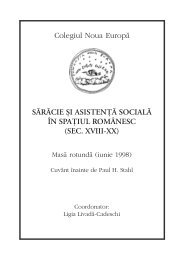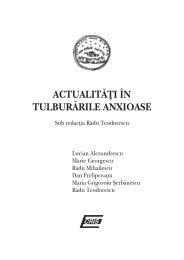New Europe College Regional Program Yearbook 2001-2002
New Europe College Regional Program Yearbook 2001-2002
New Europe College Regional Program Yearbook 2001-2002
Create successful ePaper yourself
Turn your PDF publications into a flip-book with our unique Google optimized e-Paper software.
N.E.C. <strong>Yearbook</strong> <strong>2001</strong>-<strong>2002</strong><br />
cults, E. Morin also defines fecundity as solicited by death, and death as<br />
“universal source of fertility” (Morin 1970: 129).<br />
6 Seale 1998:194. For a thorough analysis of the evolvement of this doctrine<br />
in Western Christianity v. Bynum 1995.<br />
7 In archaic thought, for which the elementary experiences of the world are<br />
those of metamorphoses, disappearances, reappearances and<br />
transmutations, as E. Morin observes, “all death is informed by rebirth, every<br />
birth is preceded by death, every change is analogous to death-andregeneration<br />
– and the cycle of human life is inscribed in the natural cycles<br />
of death and rebirth” (Morin 1970:123).<br />
8 Cf. Nabat Pamyati – Sovetskie memorial’nye ansambli, posviashtenye<br />
zhertvam fashizma. “Iskusstvo”, Leningradskoe otdelenie.<br />
9 About the post-World War II monuments in GDR, v. Frank 1970.<br />
10 For a detailed analysis of this monument v. Young 1989; Young 1993.<br />
11 Cf. Pamyatnik voinam sovetskoj armii pavshim v boiah fashizmom, Berlin,<br />
Treptow-Park, Moskva, 1961.<br />
12 The establishment of the communist regimes in Eastern <strong>Europe</strong> was facilitated<br />
to a large extent by the moral, administrative, and economic vacuum left by<br />
the Nazis and their allies after the Second World War (A. Aman), and by the<br />
symbolic capital communist parties gained as taking the posture of “liberators<br />
from fascism”. For the history of antifascist movements before and after the<br />
World War II, and the specificity of communist antifascism, v. esp. Groppo<br />
2000.<br />
13 The evolving scenes of Stalin monuments in Budapest depicted the history<br />
of the Soviet soldier until the liberation of the Hungarian people, while the<br />
other part represented “life renewing in its wake – the sharing out of the land<br />
to the peasants, the reconstruction, pioneers, soldiers, sportsmen, etc.”. Cf.<br />
Béke 1992:278.<br />
14 Cf., for example, the widely popularized in the socialist aesthetics phrase of<br />
V. Mayakovski about slogans and art in general as “artillery, beating at the<br />
rear rows of the enemy”.<br />
15 The characteristic representation of the dead in the 15 th century was a twotiered<br />
tomb, whose upper part represents the body in glorious clothes and<br />
armor, while the lower part is a representation of the corpse in the process of<br />
decay. Cf. Cohen 1973; Panofsky 1964; Tristram 1976:15.<br />
16 Cf. Warner 1985; about the rare presence of female figures in the First World<br />
War monuments, v. Agulhon <strong>2001</strong>:37.<br />
17 For some basic aspects of the constitution of heroes in culture and history,<br />
v. Campbell 1972 (1949); Raglan 1979 (1936); Fabre 1999; Centivres et al.<br />
1999.<br />
18 Compare with Tertulian’s note about Christian martyrdom – “the leg feels no<br />
pain in its tendons when the soul is in heaven” (quoted in Bynum 1995:45).<br />
The promise of rising again, C. W. Bynum emphasizes, “makes it possible<br />
288







